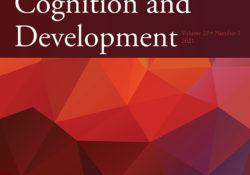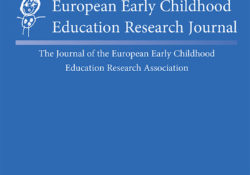eric.ed.gov har udgivet: This report focuses on the results of the second year of this longitudinal study–the 2014-2015 Georgia’s Pre-K Program Evaluation. The purpose of this evaluation study was to examine initial longitudinal outcomes related to school readiness for children and the quality of their classrooms from pre-k through kindergarten. The primary evaluation questions addressed included: (1) What are the learning outcomes through kindergarten for children attending Georgia’s Pre-K Program; (2) What factors predict better learning outcomes for children; and (3) What is the quality of children’s experiences in pre-k and kindergarten? To address these questions, the evaluation study included a sample of 1,169 children (139 Spanish-speaking dual language learners/DLLs) attending a random sample of 199 Georgia’s Pre-K classrooms in year 1, and 1,034 of these children (118 Spanish-speaking DLLs)… Continue Reading →
Like this:
Like Loading...
tandfonline.com har udgivet en rapport under søgningen “Teacher Education Mathematics”: Patterns of Development in Children’s Scientific Reasoning: Results from a Three-Year Longitudinal Study Link til kilde
Like this:
Like Loading...
tandfonline.com har udgivet en rapport under søgningen “Teacher Education Mathematics”: ABSTRACT ABSTRACT Character portrayals are important to consider when investigating the effects of educational television on young viewers. When it comes to academic interests and career aspirations, children take cues from the media representations around them. This study is a content analysis of STEM-focused children’s television shows, with attention to gender and race representation amongst the characters in those programs. Across 90 episodes of programs that claim to teach STEM to young children, 1,086 unique speaking characters were coded on demographics, physical attributes, centrality to the plot, and modeling of STEM behaviors and occupations. Following traditional industry trends, female and minority characters were underrepresented in these programs compared to population statistics. However, when it came to the centrality of their… Continue Reading →
Like this:
Like Loading...
eric.ed.gov har udgivet: The purpose of the 2013-2014 Georgia’s Pre-K Program Evaluation was to examine the learning outcomes for children and the quality of their classrooms during Pre-K, as the baseline year of the Pre-K through third-grade longitudinal study. The primary evaluation questions addressed included: (1) What are the learning outcomes for children attending Georgia’s Pre-K Program?; (2) What factors predict better learning outcomes for children?; and (3) What is the quality of children’s experiences in Georgia’s Pre-K classrooms? To address these questions, the evaluation study included a random sample of 199 Georgia’s Pre-K classrooms and a sample of 1,169 children attending these classrooms. Researchers conducted individual child assessments near the beginning and end of the Pre-K year to examine growth in children’s skills. The assessment measures covered multiple domains… Continue Reading →
Like this:
Like Loading...

tandfonline.com har udgivet en rapport under søgningen “Teacher Education Mathematics”: ABSTRACT ABSTRACT Whereas previous studies show that children are able to make meaning about evolutionary concepts within read-aloud contexts, little is known about how semiotic resources and interaction influence children’s meaning making about evolution. This study investigates children’s meaning making about evolutionary concepts during a modelling activity conducted after an interactive storybook read-aloud describing the evolution of a foraging trait of a fictitious mammal (the pilose). Forty children (13 groups) were videotaped as they produced a clay pilose model, while explaining how they thought their pilose would appear after inhabiting a ‘future’ environment (mountainous, snowy or forest). A multimodal analysis focused on how children demonstrated their meanings of seven evolutionary concepts described in the book. An eighth concept, ‘adaptation to… Continue Reading →
Like this:
Like Loading...
eric.ed.gov har udgivet: This executive summary presents results from a study that began in 2013-2014, and involves a longitudinal design to follow a sample of 1,169 children (139 Spanish-speaking DLLs) who attended 199 randomly-selected Georgia’s Pre-K classrooms. These findings focus on results from the second year of the study, which included 1,034 of these children (118 Spanish-speaking DLLs) who were attending kindergarten. Researchers conducted individual child assessments near the beginning and end of pre-k and kindergarten to examine growth in children’s skills, as well as factors associated with greater growth. The assessment measures covered multiple domains of learning, including language, literacy, math, and general knowledge, and teacher ratings of behavior skills. For the DLL subsample, assessments were conducted in both English and Spanish using parallel measures. Researchers also conducted observations… Continue Reading →
Like this:
Like Loading...
eric.ed.gov har udgivet: This paper reports on a study of parental involvement in children’s mathematics learning in the context of a series of workshops carried out in four primary schools in the United Kingdom. Previous research suggests that, while there are high correlations between parental involvement and positive student outcomes, it can be difficult to raise student achievement via parental involvement interventions. We suggest that part of the reason for this, at least in relation to mathematics, is that parents experience considerable difficulties in negotiating school-centered definitions of and approaches to mathematics. We employed a design and analytic approach informed by Derridean concepts including decentering and différance. We encouraged parents to work with their children to “find the math” in everyday life and activity. A significant component of the discussion… Continue Reading →
Like this:
Like Loading...
eric.ed.gov har udgivet: The objective of preschool teachers should be to determine the mathematical ability of preschool children and improve their skills using meaningful teaching methods through pictorial demonstration and manipulative models. Children who receive number concept instruction through hands-on play models, activities, and discussion show greater understanding in math skills. Teachers should be striving to create a learning environment for their students and help them fulfill their needs through their playful activities. This paper discusses how to integrate math activities into preschool classrooms. (ASK) Link til kilde
Like this:
Like Loading...
tandfonline.com har udgivet en rapport under søgningen “Teacher Education Mathematics”: ABSTRACT ABSTRACT Using video-ethnographic data from a ‘try-on day’ in a bus-based mobile preschool, we discuss how children with different levels of experience collaborate with one another and with pedagogues to socialize newcomers into an ongoing community. Analyses show how pedagogues create moments of collective orientation and, besides through verbal instructions, invite newcomers to participate in core activities with older children. The novices engage in the priming event by intent participation, while the older children assume, and are assigned, the role of more experienced participants – ‘old-timers’. In this collective socialization, old-timers, children, and pedagogues strive to create a smooth transition for novices, particularly by stressing the specificity of participating in a preschool that is mobile and located in a… Continue Reading →
Like this:
Like Loading...
eric.ed.gov har udgivet: Teachers increasingly use virtual manipulatives and other apps on touch-screen devices (e.g., “iPads”) in an effort to help students understand mathematics concepts. However, students experience these apps and their affordances in different ways. The purpose of this article is to inform teachers’ decisions about app implementation in the classroom through discussion of four case studies illustrating ways children interacted with the app “Motion Math: Zoom,” and how these interactions revealed, concealed, and developed children’s mathematical understanding. These results suggest that mathematics virtual manipulative apps on touch-screen devices can be useful tools when thoughtfully implemented. Teachers can balance technological distance by assisting students who need help as they learn the technology required to interact with the app. This may include explicitly using scaffolding provided by the app, leading… Continue Reading →
Like this:
Like Loading...



